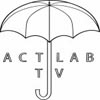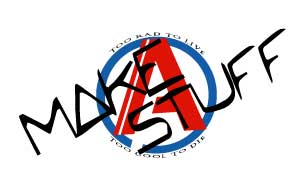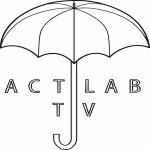(please note, this text was modified and mangled from www.sandystone.com, old actlab sites and unknown sources that showed up late one night.)
ACTLab Pedagogy- ON BEING TRANS, AND UNDER THE RADAR:
TALES FROM THE ACTLAB
Allucquére Rosanne Stone
Thanks to ISEA and to the dedicated staff at Switch for allowing me this opportunity to say something about Transpractices, and I'd particularly like to direct this to those of us who are teacher-practitioners, which is to say, artists who teach for the love of teaching. I'd also like to frame this in terms of some experiences I've had in relation to my own and my culture's concepts of gender.
There are lots of misconceptions about how gendered identity works, so let's clarify as best we can. Firstly, in the case of Transgender there is nothing transitory about Trans. The fact is that if you are Trans, then, to pervert Simone de Beauvoir, one is neither born a woman nor becomes one; Trans is all there is. In the same way that Brenda Laurel pointed out that if you're designing an immersive world then for a participant in it the simulation is all there is, if you start out as Trans, then Trans is all there is. If you are lucky, you discover that you don't become assimilated into one of the existing categories because you can't.
Realizing that you can't may be a powerful strategy. Glória Anzaldùa described this as mestiza consciousness — a state of belonging fully to none of the possible categories. She talked about being impacted between discourses, about being everywhere but being at home nowhere. She spoke in terms of cultural impaction or what in geology is called subinclusion, though her words apply as fully to our experience.
To
survive the Borderlands
you must live sin
fronteras
be a crossroads11
At around the same time Anzaldùa wrote those words, other people were realizing that existing languages were frequently inadequate to contain new forms of thought and experience.10 These people invented new languages to allow new modes of thought: languages with names like Laadan, Kesh, Ktah'meti...”fictional” (in the best sense) languages meant to enable new practices. Laadan, for instance, was a language in which truth values were encoded right into speech, so an utterance had to contain information about whether the speaker had actually witnessed the event being described, or whether the information had come to them second or third hand or in some other way. Laadan addressed itself to a specific set of problems, namely that language is a vehicle for deception, and it set out to make that impossible. And so forth, for other needs in other situations.
Why invent new words? Because your language is a container for your concepts, and because political power inevitably colonizes language for its value as a technology of domination. Recent neologist practices come from poetic (and poststructuralist) attempts to pull and tear at existing language in order to make visible the fabric of oppression that binds any language together, as well as to create new opportunities for expression. New words and new practices are related — as in Harry Partch's musical instruments, which enabled new musical grammars.
Language itself follows a cycle that repeats roughly once every thirty years, or once a human generation. Let's call that cycle the arc of death by naming. Here's what it looks like:
(Stone takes out her black, dog-eared notebook, digs out a worn pencil, and scribbles for a moment. Then she holds the notebook up...)
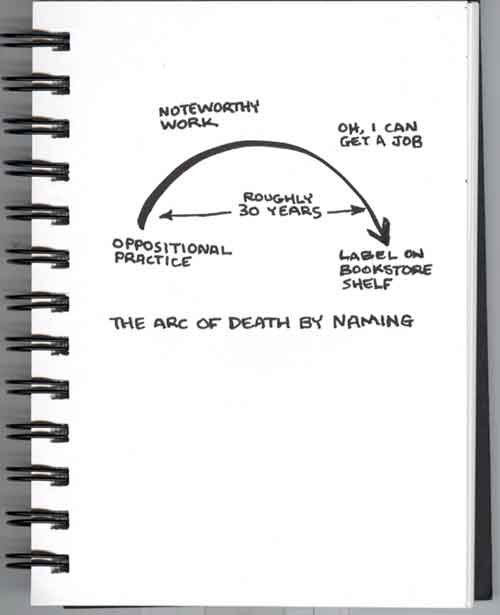
Figure 1: The arc of death by naming.
So here's the drill: Someone wakes up one day and makes something vital and interesting, something that doen't fit into any existing definition. Maybe the geist is grinning that day and so lots of people do the new thing simultaneously. Then others notice resonances with their own stuff, triggering a natural human desire to associate. They begin talking about it over coffee or dope or whatever, and their conversations inspire them. Gradually others begin to join in the discussion.
The conversation gathers energy, the body of work grows and becomes more vital and interesting. Elsewhere, people doing similar things find resonances in their own work.
Resonant groups begin to meet together to share conversations. Conferences start to happen.
Students, always alert for innovation, pick up on the new thing and talk about it.
The new thing begins to show up in the media and thereby in popular culture.
Forms of capital take notice. The thing can be marketed, or can assist other things in being marketed. A workforce is needed to produce and market it. This requires that the thing possess stable qualities over a sufficiently long period of time to maximize the marketing potential. One of the stable qualities necessary for this is a name. (Of course the other way to do this is to track trends and market them as they emerge, which rapidly exhausts the power of language inherent in a trend.)
Capital mobilizes educational institutions to produce the necessary workforce, adopting the name perceived as being most useful for this purpose. One fine day someone wakes up and says “Hey, I can get a job with that stuff.” A year or two later, sleek, suited people with hungry eyes are stalking the corridors at MLA, sniffing out the recruiters. The dance is on.
Those of us who were around in the 1980s saw this all the way through to the end with Cultural Studies, from a gleam in the eyes of innovative students to the first time Routledge catalogued a book as “Cultural Studies”. I think many of us felt with some justifiable pride that we'd finally arrived, only to realize an instant later that our discipline had come of age and died...though, as things have turned out, it's a quite serviceable zombie.
I don't think it's an accident that Cultural Studies began as an oppositional practice. I do think that virtually all worthwhile new work starts out as oppositional practice.8 The people who were practitioners of what became Cultural Studies, though they might not have known it, were trying to open space for new kinds of discourses. Because existing discourses take place in a force field of political power, there is never any space between them for new discourses to grow. New discourses have to fight their way in against forces that attempt to kill them off. Those forces fight innovation with weapons like “That's collage, not photography”, or “That isn't legitimate scholarship.”
If you're nervous about suddenly and unexpectedly finding that your discourse has been hijacked14, and that now there are shelves down at the Barnes Ignoble filled with books with your field's name on them, and that a bunch of universities are suddenly hiring people into an area or concentration with your discourse's name on it, you might want to reinvent your discourse's name as frequently as you can. This, of course, is known as nomadics, and it comes from a fine and worthy tradition. Marcos (Novak, one of the sponsors of this session) is such a one; he has been reinventing and renaming almost continually the discourses he creates, right up to and including Transvergence. Watching him makes me tired; I wish I had his stamina and his inexhaustibility.
My approach has been more or less to keep the same name for the discourse I inhabit most frequently. However, I long ago realized that if I'm not involved in an oppositional practice I'll shrivel up and die. My oppositional practices are Transgender and the ACTLab. The term Transgender has been around for roughly ten years, and the ACTLab has been around for nearly fourteen years. Transgender as a discourse has survived by steadily becoming more inclusive. I don't think many folks who were around at the inception of the term would recognize it if they saw it now, but it's certainly become more interesting.9
Okay, that's the Trans-fu teaser. I'm going to take off at a tangent now and talk about the ACTLab instead, because for me the ACTLab is an embodiment of Trans practices writ large -- it was, and remains, absolutely grounded in oppositional practices. As I said, while I do a lot of dog and pony shows about our program I've never talked about how it works. Because I want this screed to speak directly to the people who are most likely going to go out there and try to figure out how and where their own oppositional practices will allow them entry into a reactionary and hostile academy, I'm going to concentrate on writing out a sort of punch list -- ACTLab For Dummies, the nuts and bolts of an academic program specializing in Trans-fu in the sense that Marcos meant it.
Cut to the Chase
ACTLab stands for Advanced Communication Technologies Laboratory. The name began as a serviceable acronym for the New Media program of the department of radio-television-film (RTF) at the University of Texas at Austin. People used to ask us if we taught acting. We don't.
The ACTLab is a program, a space, a philosophy, and a community.
Before I tell you about those things I'll mention that if you intend to build a Trans-fu program of your own, it's crucial to know that the ACTLab would be impossible without our primary defense system: The Codeswitching Umbrella.
The Codeswitching Umbrella
Conceptually, the ACTLab operates on three principles5:
Refuse closure;
Insist on situation;
Seek multiplicity.
In reality you can't build a program on that, because (a) refusing closure is the very opposite of what academic programs are supposed to be about, and (b) insisting on situation means, among other things, questioning where your funding comes from. Also, if time and tide have shown you that your students do their very best work when you offer them almost no structure but give them endless supplies of advice and encouragement, you have precipitated yourself into a surefire confrontation with people who are paid to enforce structure and who, in order to collect their paychecks, are responsible to people who understand nothing but structure. We all have to get along: the innovators, the bean counters, and me. So to make this smooth and easy for everyone, we actlabbies live beneath the Codeswitching Umbrella.
(Stone whips out her notebook and scribbles frantically. Then she holds it up...)
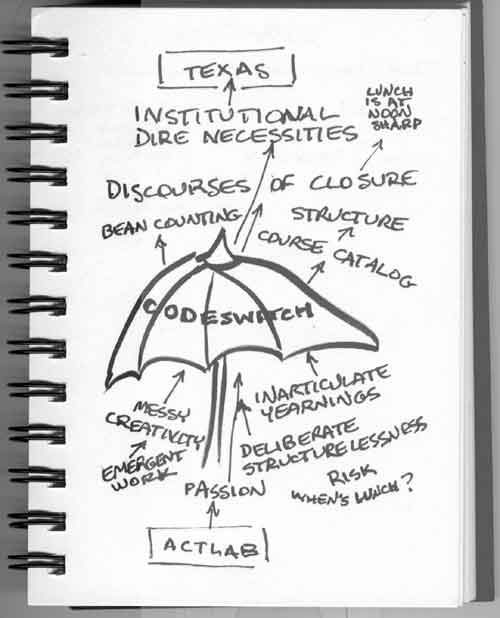
Figure 2: The codeswitching umbrella. The umbrella is opaque, hiding what's beneath from what's above and vice versa. The umbrella is porous to concepts, but it changes them as they pass through; thus “When's lunch?” below the umbrella becomes “Lunch is at noon sharp” above the umbrella. In this conceptual model the lowest subbasement level you can descend to, epistemically speaking, is the ACTLab, and the highest level you can ascend to, epistemically speaking, is Texas. Your mileage (and geography) may vary. This particular choice of epistemic top and bottom expresses certain power relationships which are probably obvious, but then again, you can never be too obvious about power relationships.
The codeswitching umbrella translates experimental, Trans-ish language into blackboxed, institutional language. Thus when people below the umbrella engage in deliberately nonteleological activities, what people above the umbrella see is organized, ordered work. When people below the umbrella produce messy, inarticulate emergent work, people above the umbrella see tame, recognizable, salable projects. When people below the umbrella experience passion, people above the umbrella see structure.
When you think about designing your program, you'll realize that institutional expectations chiefly concern structure. Simultaneously, you'll be aware that novel work frequently emerges from largely structureless milieux. Structureless exploration is part of what we call play. A major ACTLab principle is to teach people to think for themselves and to explore for themselves in an academic and production setting. We use play as a foundational principle and as a homonym for exploration. How we deploy the concept of play is not just by means of ideas or words; it's built right into the physical design of the ACTLab studio.
The ACTLab studio
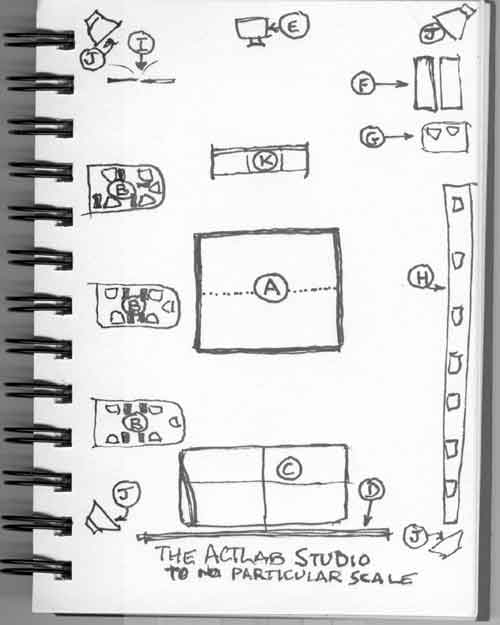
Figure 3: The ACTLab studio. Legend: (A) Seminar table (the dotted line shows where the two rectangular tables join); (B) Pods; (C) Thrust stage; (D) Screen; (E) Video projector; (F) Theatrical lighting dimmerboard and plugboard; (G) Workstation connected to projector and sound system; (H) Wall-o-computers, which I could claim is there merely to break the interactivity paradigm but which in fact is there because we ran out of space for more pods; (I) Doors; (J) Quadraphonic speakers (these are halfway up the walls, or about twenty feet off the ground); (K) Couch. Actually the couch is a prop which can be commandeered by production students doing shoots, so it's sometimes there and sometimes not. Although my lousy drawing shows the space as rectangular (well, my notebook is clearly rectangular), the room is actually a forty-foot cube with the lighting grid (not shown) about twenty feet up.
It's hard to separate the ACTLab philosophy from the studio space, and vice versa. They are co-emergent languages. The ACTLab studio is the heart of our program and in its semiotics it embodies the ACTLab philosophy. At the center of the space is the seminar table. The table is a large square around which we can seat about twenty people if we all squeeze together, and around fifteen if we don't. The usual size of an ACTLab class is about twenty, so in practice fifteen people sit at the table and five or so sit in a kind of second row. Because the “second row” includes a couch, people may jockey for what might look like second-class studentship but isn't.
Ideally the square table would be a round table, because the philosophy embodied in the table is there to deprivilege the instructor. Most other classrooms at UT consist of the usual rows of seats for students, all bolted to the floor and facing the instructor's podium. We needn't emphasize that this arrangement already incorporates a semiotics of domination. Whatever else is taught in such a room, the subtle instruction is obedience. There's nothing obvious about using a round table instead, but the seating arrangement delivers its subtle message to the unconscious and people respond. The reason the table is square instead of round is that we need to be able to move it out of the way in order to free up the floor space for certain classes that incorporate movement and bodywork. In order to make this practical the large square table is actually two rectangular tables on wheels which, when separated, happen to fit neatly between the computer pods; or, if we happen to need the pods at the same time as the empty floor, the two tables can be rolled out the door and stored temporarily in the hall.
The computers in the studio are arranged in three “pods”, each of which consists of five workstations that face each other. When you look up from the screen, instead of looking at a wall you find yourself looking at other humans. Again, even in small ways, the emphasis is on human interaction. (As we grew, there wasn't room to have all the workstations arranged as pods, so newer computers still wind up arranged in rows along the wall. We'll fix that later...)
Let's get the sometimes vexing issue of computers and creativity out of the way. Although we use computers in our work, we go through considerable effort to place them in proper perspective and deemphasize the solve-everything quality they seem to acquire in a university context. In particular we go to lengths to disrupt closure on treating computers as the wood lathes and sewing machines of our time; that is, as artisanal tools within a trade school philosophy, tools whose purpose and deployment are exhaustively known and which are meant to dovetail within an exhaustive recipe for a fixed curriculum. While we're not luddites, our emphasis is far more on flexibility, initiative, creativity, and group process, in which students learn to select appropriate implements from a broad range of alternatives and also to make the best possible use of whatever materials may come to hand. In this way we seek to foster the creative process, rather than specific modes of making.
Besides the seminar table and the inescapable computers, the ACTLab studio features a large video projection system, quadraphonic sound system, thrust stage, and theatrical lighting grid. These are meant to be used individually or in combination, and emphasize the intermodal character of ACTLab work. We treat them as resources and augmentations.
As with our physical plant, ACTLab faculty and staff are meant to be resources. Thinking Trans-fu here, as I encourage us to always do, we shouldn't take the idea or definition of resources uncritically, without some close examination of how "resource" means differently inside and outside the force fields of institutional expectations and nomadic programs.
Rethinking resource paradigms
If you design your Trans-fu program within a traditional institutional structure you may find that the existing structure, by its nature, can severely limit your ability to acquire and maintain resources such as computers. It can do this by the way it imposes older paradigms that determine how resources should, usually in some absolute sense, be acquired and maintained. To build an effective program, think outside these resource-limiting paradigms from the outset, and instead rethink resource paradigms just like curricular paradigms -- that is, as oppositional practices.For example, when we established the ACTLab in 1993 there was no technology infrastructure in our college, no coordinated maintenance or support. Then, to our dismay, we found that by virtue of preexisting practices of hiring staff with preexisting skills and preexisting assumptions about the "right way" to build those infrastructures, the university, perhaps unintentionally, perpetuated hugely wasteful resource paradigms. At most institutions this happens in the guise of solid, reliable procedures that are "proven" and "known to work", and it's also possible that it is fallout from sweetheart deals between manufacturers and the institution.13
For example, in its existing resource paradigms our institution assumes a radical disjunct between acquisition, support, and use. Because the paradigms themselves are designed by the acquisitors and supporters, users are at the bottom of that pile, and while in theory the entire structure exists to make equipment available to users, in practice the actual users are almost afterthoughts in the acquisition-support-user triad. Contrariwise, the Trans-fu approach is to see the triad as embedded in old-paradigm thinking, and to virally penetrate and dissolve the boundaries between the three elements of the triad. For example, if you have designed your program well, you will find that it attracts students with a nice mix of skills, including hardware skills. In the ACTLab we've always had a critical mass of hardware geeks, which is to say that a small but significant percentage of our student population has the skills to assemble working computers from cheap and plentiful parts. It's helpful here to recall one of the definitive Trans principles, which of course we share with all distributed systems: a distributed system interprets chronic inefficiency as damage, and routes around it. Trans resource paradigms share this quality as well. A student population with hardware skills is a priceless resource for program building, because it gives one the unique ability to work around an institution's stunningly inefficient acquisition and maintenance procedures. Doing so reveals another aspect of running under the radar, which is that you can do it in plain sight and still be invisible.
Let's run the numbers. At our institution, if you follow the usual materiel acquisition path, before you can purchase significant hardware the university's tech staff must accept it as worthy of their attentions and agree to support it. For our university's technical support staff to be willing to support a piece of hardware, it must be purchased from a large corporate vendor as a working item and then maintained only by the technical staff. The institution intends the requirement for a large corporate vendor to assure that the vendor will still be there a few years down the road to provide support to the institution's in-house tech staff as necessary. This sets the base acquisition cost for your average PC at roughly US$2500, and requires you to sign on to support a portion of a chain of tech staff at least three deep -- which includes salaries, office space, and administrative overhead. On average this adds an additional $1000 per year to the real cost of owning a computer. We don't pay these costs directly, but the institution factors them into the cost of acquiring equipment. Also, because the commercial computer market changes so fast, after about a year this very same computer is worth perhaps half of what it cost.
On the other hand, if we make building computers part of our curriculum, and build our own computers from easily available parts, we can deploy a perfectly serviceable machine for something in the vicinity of $600. By building it from generic parts, we put most of our dollars into the hardware itself, instead of having to pay a portion of the first cost to finance a brand-name manufacturer's advertising campaign. After a year of use such a box has depreciated hardly at all. When it breaks, instead of supporting a large and cumbersome tech support infrastructure we simply throw it away. If on average such a box lasts no more than a year, we have already saved more than enough in overhead to replace it with an even better one.
This nomadic Trans-fu philosophy of taking responsibility for one's own hardware, thinking beyond traditional institutional support structures, and folding hardware acquisition into course material, results in a light, flexible resource paradigm that gives you the ability to change hardware priorities quickly and makes hardware turnover fast and cheap -- the very antithesis of the usual institutional imperatives of conservation.
ACTLab curriculum
When you build your Trans-fu program you will be considering what your prime directive should be. The ACTLab Prime Directive is Make Stuff. By itself, Make Stuff is an insufficient imperative; to be insitutionally viable we have to translate that into a curriculum. The purpose of a curriculum is to familiarize a student with a field of knowledge. Some people believe you should add “in a logical progression” to that. With New Media the “field” is always changing; the objects of knowledge themselves are in motion, and you have to be ready to travel light. However, when we observe the field over the course of the last fifteen years, it's easy to see that although this is true, some things remain constant. For the purposes of this discussion I'm going to choose innovation, creativity, and play. The ACTLab curriculum has a set of specifics, but our real focus is on those three things.2
As we discuss curriculum I want to remind you of the necessity to keep in mind the nomadic imperative of Trans-fu program building: refuse closure. When you want to focus on innovation, creativity, and play, one of your most important (and difficult) tasks is to keep your curricular content from crystallizing out around your course topics. We might call this approach cyborg knowledges. In A Manifesto for Cyborgs, Donna Haraway notes that cyborgs refuse closure. In constructing ACTLab course frameworks, refusing closure is a prime directive: we endeavor to hold discourses in productive tension rather than allowing them to collapse into univocal accounts. This is a deliberate strategy to prevent closure from developing on the framework itself, to make it difficult or impossible for an observer to say “Aha, the curriculum means this”. Closure is the end of innovation, the point at which something interesting and dynamic becomes a trade, and we're not in the business of teaching a trade.
Still, we have to steer past the rocks of institutional requirements, so we need to have a visible structure that fulfills those requirements. Once again we look to the codeswitching umbrella. Above the umbrella we've organized our primary concerns into a framework on which we hang our visible course content. The content changes all the time; the framework does not. For our purposes it's useful to describe the curriculum in terms of a sequence, but this is really part of the codeswitching umbrella; in practice it makes no difference in which order students take the courses, and in fact it wouldn't matter if they took the same course eight times, because as the semester progresses the actual content will emerge interactively through the group process. The real trick, then, the actual heart of our pedagogy, is to nurture that group process, herd it along, keep it focused, active, and cared for.3
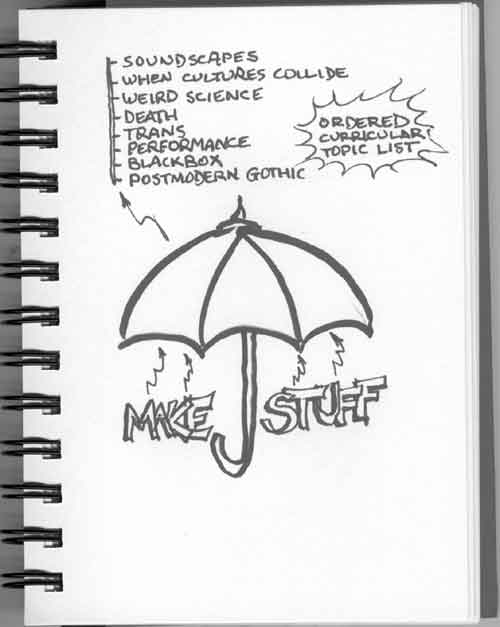
Figure 4: The ACTLab Prime Directive, which is based on messy creation and the primacy of play, filters through the codeswitcher umbrella to reappear as a disciplined, ordered topic list. In this instance the umbrella performs much the same numbing function as Powerpoint. (Also notice that my drawing improves with practice; this is a much better umbrella than the one in Figure 2.)
There are eight courses in the ACTLab sequence, and we consider that students have acquired proficiency when they have completed six. We try to rotate through all eight courses before repeating any, but sometimes student demand influences this and we repeat something out of sequence.
The ACTLab pedagogy requires that graduate and undergraduate students work together in the same courses. We find that the undergrads benefit from the grads' discipline and focus, and the grads benefit from the undergrads' irreverence and boisterous energy.
As I mentioned, our curricular philosophy is about constructing dynamic topic frameworks which function by defining possible spaces of discourse rather than by filling topic areas with facts.12 With this philosophy the role of the students themselves is absolutely crucial. The students provide the content for these frameworks through active discussion and practice. The teacher acts more as a guide than as a lecturer or a strong determiner of content.
For an instructor this can be scary in practice, because it depends so heavily on the students' active engagement. For that reason, during the time that the program is ramping up and acquiring a critical mass of students who are proficient in the particular ways of thinking that we require, we spend a significant amount of time at the beginning of each semester doing “boot camp” activities, in which we demonstrate through practice that we don't reward rote learning, question-answer loops, or authority responses, but do reward independent thinking, innovation, and team building.
I'll list the titles of the eight active ACTLab topics here, but keep in mind that in a Trans-fu curriculum model like the ACTLab's the courses do not form a sequence or progression. There is no telos, in the traditional sense. That's why we call them clusters. Their purpose is to create and sustain a web of discourses from which new work can emerge. Like the Pirates' Code, the titles are mere guidelines, actually:
Weird Science
Death
Trans
Performance
Blackbox
Postmodern Gothic
Soundscapes
When Cultures Collide
Because the course themes are not the point of the exercise, we're always thinking about what other themes might provide interesting springboards for new work. Themes currently in consideration, which may supplement or replace existing themes, depending upon how they develop, are:
Dream
Delirium
(You probably noticed that some of these topics read like headers for a Neil Gaiman script. I think a topic list based on Gaiman's Endless would be killer:))
A brief expansion of each topic might look like this:
Weird Science: Social and anthropological studies of innovation, the boundaries between "legitimate" science and fakery, monsters and the monstrous, physics, religion, legitimation, charlatanism, informatics of domination.
Death: Cultural attitudes toward death, cultural definitions of death, political battles over death, cultural concepts of the afterworld, social and critical studies of mediumship, "ghosts" and spirits, zombies in film and folklore; the spectrum of death, which is to say not very dead, barely dead, almost dead, all but dead, brain dead, completely dead, and undead.
Trans: Transformation and change, boundary theory, transgender, gender and sexuality in the large and its relation to positionality and flow; identity.
Performance: Performance and the performative, performance as political intervention, history and theory of theatre, masks, puppetry, spectacle, ritual, street theatre.
Blackbox: Closure, multiplicity, theories of discourse formation, studies and practices of innovation, language.
Postmodern Gothic: Theories and histories of the gothic, modern goth, vampires, monsters and the monstrous, genetic engineering, gender and sexuality, delirium, postmodernity, cyborgs.
Soundscapes: Theory and practice of audio installation, multitrack recording, history of "music" (in the sense described by John Cage). (Note that unlike all the other topics this one is very specific, and because its specificity tends to limit the range of things the students feel comfortable doing, it's likely going to be retired or at least put into a secondary rotation like songs that fall off the Top 40.)
When Cultures Collide: Language and episteme, cultural difference, subaltern discourses, orientalism, mestiza consciousness. (This topic has a multiple language component and we had a nice deal with one of the language departments by which we shared a foreign (i.e., not U.S. English) language instructor. With visions of Gloria Anzaldua dancing in our heads we began the semester conducting class in two languages: full immersion, take-no-prisoners bilinguality. Three weeks into the semester he suddenly got a great gig at another school, and the course sank like an iceberged cruiser. Since then I've been wary about repeating it, and I suspect that -- unless I can find an instructor who will let me keep their firstborn as security -- it's not likely to come up in the rotation again any time soon.)
So that's what I consider to be a totally useless description of the ACTLab curriculum, useless because the curriculum itself is a prop for the Trans-fu framework which underlies it. Remember the curriculum is above the codeswitching umbrella. And therefore it's important to those necessary deceptions that make a Trans-fu program look neat, presentable, and legit.
ACTLab pedagogy
When we discuss Trans-fu pedagogy I always emphasize the specifically situated character of the ACTLab's pedagogical imperatives. I think the default ACTLab pedagogy was heavily influenced by having come of academic age in an environment in which our mentors were, or at least were capable of giving us the illusion that they were, all very comfortable with their own identities and accomplishments. There was no pressure to show off or to make the classroom a sounding board for our own egos. This milieu allowed me the freedom to develop the ACTLab's predominant pedagogical mode. It primarily consists of not-doing. Ours is the mode of discussion, and you can't create discussion with a lecture. Those are incompatible modes. You may encourage questions, but questions aren't discussion, and though questions may take you down the road to discussion it's better to bushwhack your way directly there.
Other faculty have their own teaching methods, some of which are more constructivist, but I encourage people to teach mostly by eye movement and body position.7 Usually class starts off with someone showing a strange video they found, or a soundbyte, or an odd bit of text, or someone will haul out a mysterious hunk of tech and slap it on the table. Most times that's enough, but in the event that it isn't, the instructor may ask a question.6 For the rest of the time, when it's appropriate to encourage responses, the instructor will turn her body to face the student. In this situation the student naturally tends to respond directly to the instructor, and when that happens, the instructor moves her eyes to look at another student. This leads the responder's eyes to focus on that student too, whereupon the instructor looks away, breaking eye contact but leaving the students in eye contact with each other.
That's a brief punch list of what I consider the minimum daily requirement for building a useful and effective program based on Trans-fu principles. The ACTLab's pedagogical strategies, together with semiotically deprivileging the instructor through the design and position of chairs, tables and equipment in the studio, plus refusing closure, encouraging innovation, and emphasizing making, help us create the conditions that define the ACTLab. I think it's obvious by now that all of this can be very easily rephrased to emphasize that the ACTLab, like any entity that claims a Trans-fu positionality, is itself a collection of oppositional practices. Like any oppositional practice, we don't just live under the codeswitching umbrella; we also live under the institutional radar, and to live under the radar you have to be small and lithe and quick. We cut our teeth on nomadics, and although we've had some hair-raising encounters with people who went to great lengths to stabilize the ACTLab identity, we're still nomadic and still about oppositional practices.
I'm writing this for ISEA at this time because, although we've been running a highly successful and unusual program based on a cluster of oppositional practices for almost fourteen years now, a new generation of innovators are about to begin their own program building and I've never said anything publicly about the details that make the ACTLab tick. I'm also aware that our struggles tend to be invisible at a distance, which can make it appear that we simply pulled the ACTLab out of a hat -- which I think is a dangerous misconception for people to have if they intend to model their programs to any extent on what we've done. People who've been close up for extended periods of time tend to be more sanguine about the nuts and bolts of putting such a program together. Some very brave folks who have crouched under the radar with us have taken the lessons to heart, gone out and started Trans-fu programs of their own. Some of them have been very successful. Usually other programs simply adapt some of our ideas for their own purposes, but very few have actually made other programs like the ACTLab happen. Recently we've talked about how people who've never had the opportunity to participate in our community would think about New Media as an oppositional practice, and what, with a little encouragement, they might decide to do about it. I'd like to close by saying that however you think about it or talk about it, at the end of the day the only thing that matters is taking action. I don't care what you call it -- New Media, Transmedia, Intermedia, Transitivity, Post-trans-whazzat-scoobeedoomedia -- whatever. The important thing is to do it. Music is whatever you can coax out of your instrument. Make the entering gesture, take brush in hand, pick up that camera. We're waiting for you.
------------------------------------
Acknowledgements
The ACTLab and the RTF New Media program exist because a lot of people believed and were willing to work to make it happen and keep it happening. A much too short list includes Vernon Reed, Honoria Starbuck, Rich MacKinnon, Smack, Drew Davidson, Harold Chaput, Brenda Laurel, Joseph Lopez, and Brandon Wiley. Special thanks to my colleague Janet Staiger for her unfailing support, and to my husband and colleague Cynbe, who from his seat on the fifty-yard line has seen far too much of the joys and tears of building this particular program. And, of course, to Donna Haraway, the ghost in our machine.
Notes
1. Some people add “digital” to this mix in some fashion or other; hence “digital art”, “digital media”, et cetera. Digital-fu is unquestionably part of the field, but there is a tendency on the part of just about everyone to expand the digital episteme beyond any limit and give it way too much importance as some godzilla-like ubertech. Digital is great, but it isn't everything, and it will never be everything. A useful parallel might be the history of electricity. When the use of electricity first became widespread, all sorts of quack devices sprang up. At one time you could go to an arcade and, for a quarter, you got to hold onto a pair of brass handles for two minutes while the machine passed about fifty volts through you. Hell, why not, it was that electricity stuff, so it must be great. That's technomania -- look, it's new, it's powerful, it's mysterious, so it must be good for everything. Electricity has become invisible precisely because of its ubiquity, in the way of all successful tech; it hegemonizes discourses and in the process it becomes epistemic wallpaper. No question electricity profoundly affects our lives, but, pace McLuhan, absent purpose electricity itself is merely a powerful force. What we do with it, how we shape its power, is key, and the same thing is true with “digital”.
2. This emphasis produces a continual tug of war with the department in which we work, because the emphasis of undergraduate courses is supposed to be on learning a trade, and learning a trade is the last thing on our minds.
3. There's neither time nor space here to devote to describing how we foster group process in the practical setting of a semester-long course. I give the topic the attention it deserves in the book from which this article is excerpted. (Don't go looking for the book; it's in progress, and if the Goddess in Her infinite sarcasm smiles on us all it'll be out next year.)
4. In passing let me note that this aspect of the ACTLab philosophy has been subject to some serious high-caliber shelling on the part of the department's administration. In fact we had to stop for a year or two while we slugged it out with the administration, but it's back now and likely to stay.
5. The three principles come from The War of Desire and Technology at the Close of the Mechanical Age (MIT Press, 1994), in which you may find other useful things. Bob Prior will be very happy if you go out and buy a copy, and he may even let me write another one.
6. From a methodological perspective the next question is, of course, what happens if nobody responds. That's rare, but it does occur. When it happens I count aloud to twenty, thereby deconstructing the pedagogy (Methods 101: Count silently to twenty before moving things along) and sometimes making someone nervous enough to blurt out a remark, though actlabbies are a notoriously tough group when faced with that situation. However, on very rare occasions even that strategy fails, in which event I send everyone home. It is our incredible good fortune to have classes filled with people who come there to do the work, and if the room is dead there's usually a good reason, even though I may not know precisely what it is.
7. One of the most perplexing and hilarious encounters I've had in my years with the department was when I came up for tenure and they sent a traditional constructivist to evaluate my teaching skills. His report read, virtually in its entirety: “Dr. Stone just sat there for three hours.”
8. Che Sandoval, now at UCSB, was referring to the same thing when she theorized oppositional consciousness in the late '80s.
9. I don't want to get into it here, but something about the fact that there are now jobs in academia in something called Transgender Studies makes me nervous. As the philosopher Jimmy Buffett asserts, I don't want that much organization in my life.
10. The phenomenon of artificial languages created de novo essentially as oppositional practices seemed to be associated in particular with the emergence of second wave American feminism in the 1970s, though work remains to be done on understanding the phenomenon. In regard to academic jargons, the dense jargon of poststructuralism was particularly intended as an oppositional practice, a tool to undermine the academic use of language as power; and it did so in a particularly viral way. Unfortunately, the distance between “true” poststructuralist jargon and what was nothing more than strategies for concealing mediocre work inside nearly incomprehensible rhetoric proved to be much too close for comfort.
11. From Gloria Anzaldua, Borderlands/La Frontera. San Francisco: Spinsters/Aunt Lute 1987.
12. The extent to which the ACTLab community considers naming our discipline to be both crucial and deadly and therefore to be approached with irony and humor may best be exemplified by our response to a request from the Yale School of Architecture. Those nice folks in New Haven wanted me to go up there and describe our program and in particular to tell them what we called our discipline. To prepare for this, each person in the ACTLab wrote a single random syllable on a scrap of paper. We put the scraps in a box, and then, to the accompaniment of drumming and tribal vocalizations, I solemnly withdrew two slips of paper and read them out. Based on this result, I proceeded to Yale and explained to them that our discipline was called Fu Qui. John Cage would have instantly recognized what we were doing.
13. Those deals may be either benign (economies of scale that have side effects of limiting purchase options) or malignant (pork). In a place like Texas you don't want to be noticed questioning pork, which is another reason that it's nice to be down under the radar, being lithe and quick and running silent, not attracting attention.
14. I think we need a term for discourse hijacking. Disjacking?






